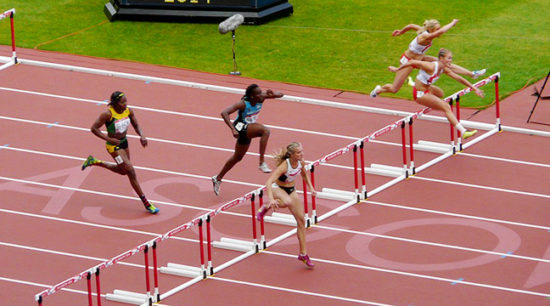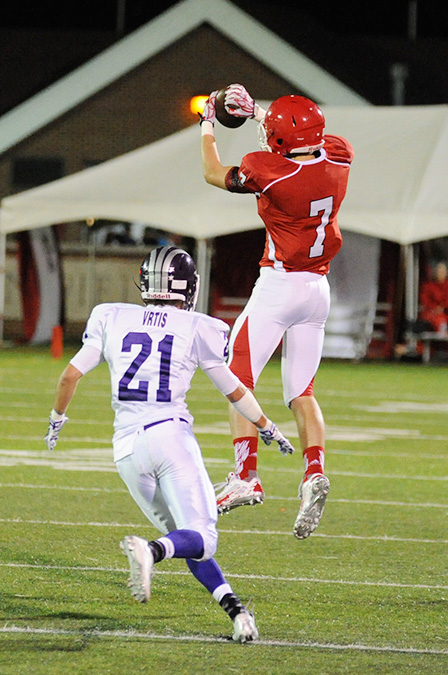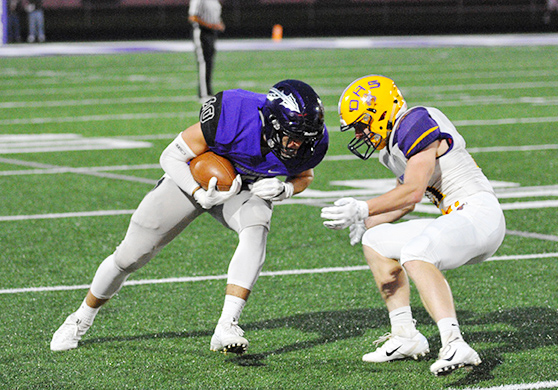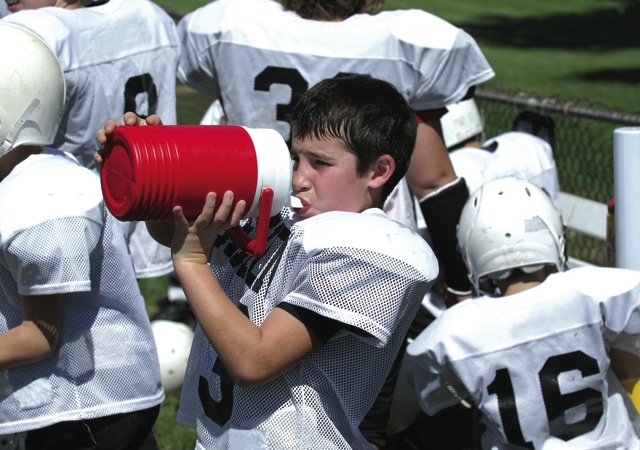Machinery and mechanisms of speed improvement

Speed training protocols are widely varied and sometimes conflicting. One thing you can be assured of, however, is that they are high on every coach’s priority list.
In my early coaching years, I read every piece of speed training literature available, sought out the expertise of speed gurus and experimented with every gadget that promised to develop lightning fast speed. And, to this day, I maintain an open mind to doing much of the same.Most of the techniques, mechanics and related coaching cues presented here stem from the interactions I’ve been privileged to have with Jim Bibbs, former track and field coach at Michigan State; Randy Gillon, our current sprinter’s and hurdler’s coach; Jim Kielbaso, who runs a state-of-the-art training center in Wixom, Michigan; and legendary speed coach, Kevin McNair.
Understanding speed development
Several primary pieces to the speed-development puzzle — which most experts agree on — must be understood up-front, for true, realistic goals to be attained:
• Elite speed is primarily a product of myriad, genetically inherited gifts. Those who possess it have a predetermined, raw material combination that includes the right muscle fiber type, power-producing muscle-to-tendon ratio, optimal lever length relative to body type and lightning fast neuromuscular efficiency. Proper training can certainly refine one’s mechanics, but the athletes with upper echelon speed were “cut right” at birth.
• Just about everyone can make some degree of improvement in closed-skill, straight-ahead speed. That is, from stance, to start, through a designated distance, with no required reactions to peripheral stimuli, as in a 40-yard dash.
• Open-skill speed, which is dependent upon a host of neuromuscular and sensory responses to auditory, visual and pressure cues, is a different animal. A very specific training program that encompasses all of these cues in a progressive teaching model must be organized and properly administered for improvements to be realized. Quite simply, it’s best accomplished by practicing under game/competition-like circumstances.
• A total, comprehensive program that includes strength/power training, flexibility, mobility and running mechanics should be implemented to make optimal gains in speed development.
What follows is broad-scoped overview of the speed “engine,” along with specific teaching cues and their concomitant mechanics.
Building the engine
An all-inclusive strength/power training program is a requisite to speed improvement. Initiating muscle-producing force translates into more powerful running strides. A key point of emphasis here is that running economy requires total body strength — it’s not just a lower body endeavor. The muscle structures of the neck, shoulders, chest, upper back and arms provide stability, counterbalance elements and act as ballasts from stem to stern in any running activity. Therefore, it’s vital that these muscle compartments are addressed with the same emphasis applied to the lower body.
 The abdominals, low back, hips and legs perform the brunt of the work, and certainly can be considered the machinery of a strong sprint engine. I have examined specific strength training exercises, protocols and progressions in past Powerline columns, and will continue to do so in the future.
The abdominals, low back, hips and legs perform the brunt of the work, and certainly can be considered the machinery of a strong sprint engine. I have examined specific strength training exercises, protocols and progressions in past Powerline columns, and will continue to do so in the future.
Rather than revisit specific strength training movements in this installment, I will make a point of emphasis to identify the muscular structures that all coaches should have at least a baseline familiarity.
Let’s take a closer look at this sprint engine:
- Abdominals: The four abdominal muscles (rectus abdominus, external oblique, internal oblique and transverse abdominus) serve to flex the thorax as well as rotate and laterally flex the vertebral column. These muscles are critical in trunk stabilization when running. We perform a host of abdominal exercises with body weight, medicine balls, machines, TRX straps, etc., on an ongoing basis.
- Low back: The erector spinae group (spinalis, longissimus and iliocostalis), the transversospinalis group (multifidi, rotatores and semispinalis) and the quadratus lumborum (crucial in hip extension) are paramount structures in this area. Collectively, they are responsible for extending, laterally flexing and rotating the vertebral column, in addition to extending the hip. Movements such as low back extensions, side bends, planks, hip extensions, trunk rotations, etc., should be performed on a regular basis.
- Hips: The anterior flexors of the hip (psoas major and iliacus) are crucial in leg lift and drive. The gluteals (maximus, medius and minimus) and the “deep six” muscles of the hip (piriformis, quadricep femoris, obturator internus, obturator externus, gemellus superior and gemellus inferior) serve to flex, extend, abduct, adduct, and medially or laterally rotate the hip. We perform a series of multi-joint and single-joint movements for these compartments including squats, leg press, lunges, dead lifts, hip flexion and a wide variety of hip extension exercises.
- Thighs: The anterior thigh is composed of the quadriceps group (rectus femoris, vastus lateralis, vastus medialis and vastus intermedius), which extends the knee. Rectus femoris also flexes the hip, thus making it a double-joint structure. The posterior thigh houses the hamstring group (semitendinosus, semimembranosus and biceps femoris), which flex the knee, extend the hip and tilt the pelvis posteriorly. They have a common origin at the ischial tuberosity of the inferior hip region.
The adductor group (magnus, longus, brevis, pectineus and gracilis) is located on the medial thigh and is responsible for adducting (i.e., moving the leg toward the mid-line of the body.) The tensor fascia latae and the iliotibial tract are located on the lateral thigh, and they medially rotate and abduct (i.e., moving the leg away from the mid-line of the body) the hip.
The sartorius — the longest muscle in the body — stretches from the anterior hip to the medial aspect of the knee. It flexes, laterally rotates and abducts the hip. We address all of these compartments with stretch bands and various multi-directional lunge movements.
Speed school specifics
A well-established tenet in speed training is that both stride length and stride frequency must be improved for optimal gains. Which component undergoes the most significant improvement is individually based, due to numerous genetic predispositions, as we discussed earlier.
 A universal concept, though, is that everyone can improve his or her running mechanics. Those running mechanics, with few exceptions, are applicable to all athletes with regard to efficiency and economy.
A universal concept, though, is that everyone can improve his or her running mechanics. Those running mechanics, with few exceptions, are applicable to all athletes with regard to efficiency and economy.
With the input of the coaches mentioned earlier, we have constructed a speed mechanics blueprint. They are taught with distinct, concise verbal cues that are easily interpreted so that corrections can be made while the athlete is on the run. Once in full upright running mode, they are applied as follows:
- Focus: The head should be maintained in neutral position, with the eyes focused straight ahead in a “conversational plane.” No tilting, bobbing or side-to-side turning of the head should occur.
- Arch: Sustain a slight arch in both the upper and lower back regions. A neutral pelvis, or slight anterior tilt, should be a mainstay. Adhering to this position keeps the torso and hips in an efficient, stable alignment.
- Fix: Position and lock the elbows as closely as possible to 90 degrees.
- Rotate: Rotate the shoulders (not the elbows) from the positions of hand to chest, and then hand through the hip.
- Pinch: Keep the palms of the hands facing the body and not turned downward, as is the tendency in many cases. A palms-toward-the-body position draws the elbows to the side of the body, which reduces rotational forces through the run. Hence, efficiency in the horizontal plane, which is the essence of straight-ahead speed, is maintained.
- Squeeze: A reinforcement cue regarding elbow placement, which should be relatively close to the side of the torso.
- Punch: Explode with the lead leg up and out. Don’t make the mistake of merely lifting the leg. It must be driven, or “punched,” forward.
- Snap: Drive the back leg through the hip with a dorsi-flexed foot (i.e., the front of the foot is pulled upward toward the shin) and plant it on the forefoot region. If the heel touches at all, it should be ever so slight and should never hit first.
- Extend: Lock the down leg into full extension in order to maximize power production into the subsequent punch phase. The dorsi-flexed foot can now drive hard through the running surface and push-off explosively into the next leg swing.
Teaching progression
The stance, start and running mechanics/cues should be taught slowly and deliberately. Coaches should concentrate on one or two cues at a time, and build-up from one-quarter speed to half speed, three-quarters speed and, finally, full speed.
Once the mechanics are learned, they should be practiced at full speed with two to three sets of five quality reps per set over distances ranging anywhere from 10 to 50 yards. Initially, 10-yard explosive starts are recommended, as that phase needs to be perfected before subsequent yardages can be effective.
When applying these teaching cues and mechanics, always remember that quality is much more important than quantity. Speed school is not designed to be an energy system conditioning session, but rather a skill-building endeavor. Full recovery between teaching bouts is a must, so that fatigue is not a factor in skill deterioration.
Ken Mannie is the head strength and conditioning coach Michigan State University. His column, Powerline, appears regularly in Coach & Athletic Director magazine.





